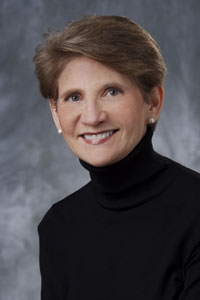 |
Virginia “Ginny” Tilden, D.N.Sc. |
To commemorate the anniversary, UNMC Today will feature stories about the college each Thursday for the next four weeks.
Dear Friends,
It may be that the only constant in life is change, but as we celebrate the 90th anniversary of the UNMC College of Nursing, let’s also celebrate another constant — excellence in nursing education delivered over nine decades by this college!
From the beginning it has been a journey of commitment — delivering top-flight educational programs, ground-breaking research and clinical services to thousands of Nebraskans who often are without other sources of care.
The 90th anniversary brings reflection on the past and future. Our start was modest. In 1917, 13 students became the founding class of a new school of nursing in Omaha. The fledgling school soon faced a massive health crisis. An influenza pandemic killed hundreds locally — 30 million worldwide — and put heavy demands on nurses. Against odds, the infant school survived that deadly threat and the Great Depression that followed. It evolved into the University of Nebraska Medical Center College of Nursing, which today is one of the top-ranked programs in the country with national and international recognition.
That’s not all that’s changed since 1917. Students no longer live in dorms or ask permission to marry. Caps and capes are gone from all but the mannequins in our History Museum — and the capping ritual has been replaced by induction ceremonies focused on ethics and professionalism.
The faculty has increased from two in 1917 to 132 full and part-time, 60 percent of whom hold doctorates. Research thrives, as reflected in the college’s ranking in the top quartile of NIH funding to schools of nursing. U.S.News and World Report ranks our graduate program among the top 8 percent in the country, ranking 32nd out of 396 schools.
In 1974, in response to what has become a persistent nursing shortage in Nebraska and nationwide, the college opened the Lincoln division, followed by Scottsbluff in 1987 and Kearney in 1991. The college has a long and responsive history of answering nursing needs, urban and rural, throughout the state.
Like America during the 20th century, the college moved with exponential speed to match the rapid industrial, technological and medical advancements of that century. It launched the BSN program in 1952, the MSN program in 1969 and the Ph.D. program in 1990 — all coming in just the last half of the college’s 90-year existence.
Across a 500-mile, statewide campus, the College of Nursing is now the largest school in the UNMC system and the largest nursing school in Nebraska, with an enrollment of more than 1,000 students in our Omaha, Lincoln, Kearney and Scottsbluff divisions. The curriculum has grown from those early diploma training years to include bachelors, master’s, doctoral and postdoctoral programs. A new initiative to bring our programs to Norfolk may ultimately mean a fifth division of the college.
The college has adapted nimbly over time to changing needs. In the 1940s, the college did its part to meet the huge demand for nurses, stateside and overseas, prompted by World War II. In the 1990s and into the new century, it addressed the deep national nursing shortage and the looming crisis of a shortfall in nursing faculty. Our graduation numbers reflect these efforts. More than 11,000 bachelors, master’s and doctoral degrees have been granted since 1917, with 80 percent of them in just the past 55 years. That figure mirrors America’s post-war, Baby Boom growth. It also reflects the college’s velocity in nursing science and in evidence-based practice and teaching.
Throughout its history, the college has aggressively sought to improve nursing practice for health promotion and disease management. In the 1950s, it prepared nurses for the polio epidemic that threatened children and struck fear in parents. In the 1960s, it addressed an unprecedented increase in communicable diseases, drug use, and mental illness — all spurred by a changing social culture and the Vietnam War. At the end of the 20th century and into the 21st, it targeted the chronic illnesses that shorten the life of Americans — obesity, heart disease and cancer — and it tackled the new problems of the era — pandemic infections and terrorism.
Long known for its academic reputation, the UNMC College of Nursing has prospered in faculty, facilities, curriculum, research, learning technologies, clinical practice initiatives, and global partnerships. We have done this with talented faculty and staff, strong leadership, a supportive UNMC administration, loyal alumni, and many, many friends of the college. We look to a bright future ahead.
Best to all,
Ginny